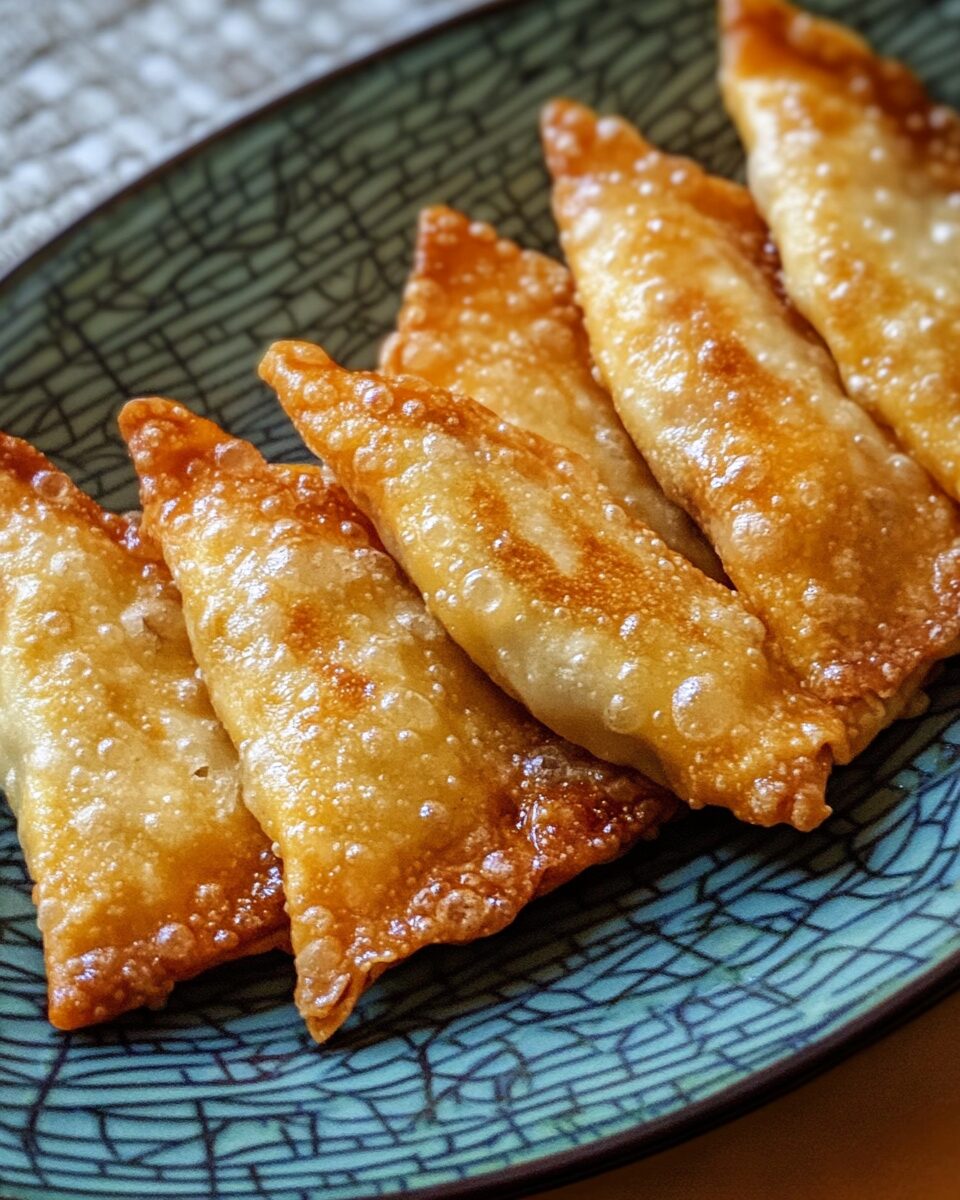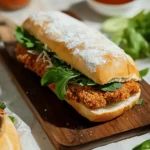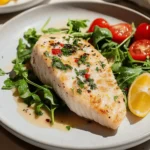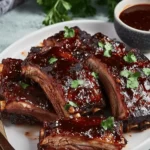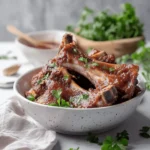Yaki Mandu are delightful Korean fried dumplings filled with a savory mixture of ground pork and vegetables. “Yaki” means fried in Japanese, and “mandu” means dumpling in Korean.
FULL RECIPE:
Ingredients
- 1 cabbage head, minced (about 2 cups)
- 1 large yellow onion, minced (about 1 cup)
- ½ cup carrots, minced
- 5 green onions, minced (about 1 cup)
- 1 lb ground pork
- 2 tsp salt
- 1 tsp Dasida beef flavor soup powder
- ½ tsp ground black pepper
- 1 garlic clove, minced
- ½ tsp soy sauce
- 1 package (12 oz) won ton wrappers
- 5 tsp avocado oil
- Dumpling dipping sauce (optional)
Directions
- Prepare the Vegetables and Meat: Heat 1 teaspoon of avocado oil in a frying pan over medium-high heat. Stir-fry the minced cabbage for about 2 minutes. Transfer to a large bowl. In the same pan, add another teaspoon of oil and stir-fry the minced onions for 3 minutes. Transfer to the bowl with the cabbage. Repeat the process for the minced carrots and green onions, cooking each for 2-3 minutes and adding them to the bowl. Add another teaspoon of oil to the pan and cook the ground pork until browned and fully cooked, about 15 minutes. Transfer to the bowl with the vegetables.
- Combine Filling Ingredients: To the bowl with the cooked vegetables and pork, add salt, Dasida beef flavor soup powder, ground black pepper, minced garlic, and soy sauce. Mix thoroughly to combine all ingredients well.
- Assemble the Dumplings: Place about 1 teaspoon of the filling mixture in the center of a won ton wrapper. Moisten the edges of the wrapper with water, fold it in half diagonally to form a triangle, and press the edges firmly to seal. Gently press the filled dumpling to remove any air pockets.
- Fry the Dumplings: Heat oil in a deep fryer to 350°F (175°C). Carefully place the dumplings into the hot oil and fry for 2-3 minutes, or until golden brown and crispy. Remove and drain on paper towels to remove excess oil.
- Serve: Enjoy the fried dumplings hot, with dumpling dipping sauce if desired.
Nutrition Facts
- Calories: 40-60 kcal
- Total Fat: 2-3 g
- Saturated Fat: 0.5-1 g
- Cholesterol: 5-10 mg
- Sodium: 100-150 mg
-
Total Carbohydrates: 5-7 g
- Dietary Fiber: 0.5-1 g
- Sugars: <1 g
- Protein: 2-4 g
History and Cultural Significance
Yaki Mandu, or fried Korean dumplings, are a delicious and crispy take on the traditional Korean dumplings known as “mandu.” The origins of mandu can be traced back to ancient Korea, with influences from China and Mongolia. Korean dumplings became widely popular during the Goryeo Dynasty when they were introduced via trade and cultural exchanges with China. Over time, these dumplings evolved into different styles, including steamed, boiled, and fried versions. Fried mandu, specifically, is a favorite street food and comfort dish in Korea. It is commonly served in Korean restaurants, at family gatherings, and as a staple during celebrations such as Lunar New Year (Seollal). The crispy, golden exterior combined with the savory filling makes it an irresistible dish for people of all ages.
Variations of Yaki Mandu
While the classic Yaki Mandu features a filling made with ground pork, cabbage, carrots, onions, and seasonings, there are many variations of this dish. Some of the popular types include:
- Kimchi Mandu – This variation includes spicy, fermented kimchi mixed with pork or tofu for a tangy and spicy kick.
- Seafood Mandu – A delicious twist that features shrimp, crab, or fish combined with vegetables for a lighter yet flavorful option.
- Vegetarian Mandu – Made with mushrooms, tofu, glass noodles, and a variety of vegetables, perfect for those who prefer plant-based meals.
- Cheese Mandu – A modern fusion that incorporates cheese into the filling, creating a gooey, creamy texture inside the crispy wrapper.
- Japchae Mandu – Features sweet potato glass noodles (japchae) mixed with vegetables and protein for a unique and chewy filling.
Best Dipping Sauces for Yaki Mandu
Yaki Mandu is often enjoyed with a variety of dipping sauces that enhance its flavor. Some of the most popular dipping sauces include:
- Soy Sauce and Vinegar – A simple yet flavorful combination of soy sauce, vinegar, sesame oil, and a hint of sugar.
- Gochujang Sauce – A spicy and slightly sweet Korean chili paste-based sauce that adds heat and depth.
- Ponzu Sauce – A Japanese-inspired citrusy soy sauce that gives the dumplings a refreshing and tangy kick.
- Sweet Chili Sauce – A mildly spicy and sweet sauce that pairs well with the crispy dumplings.
- Garlic Sesame Sauce – Made with soy sauce, garlic, sesame seeds, and a touch of honey for a rich umami flavor.
Cooking Methods Beyond Frying
Although frying gives Yaki Mandu its signature crispy texture, there are other ways to prepare Korean dumplings depending on dietary preferences and taste:
- Steamed Mandu – A healthier alternative where dumplings are steamed in a bamboo or metal steamer, resulting in a soft and juicy texture.
- Boiled Mandu – These dumplings are cooked in boiling water or broth and often added to soups like “mandu-guk,” a popular Korean dumpling soup.
- Pan-Fried Mandu – Instead of deep-frying, this method involves lightly pan-frying the dumplings with a small amount of oil until golden brown.
- Air-Fried Mandu – A modern alternative that reduces oil usage while still achieving a crispy exterior.
Tips for Making the Perfect Yaki Mandu
To ensure that your Yaki Mandu turns out perfectly crispy and flavorful, follow these expert tips:
- Use Fresh Ingredients – Fresh vegetables and high-quality meat will enhance the overall taste of the filling.
- Do Not Overfill – Overstuffing the dumplings can cause them to burst open during frying.
- Seal Properly – Use water or egg wash to tightly seal the dumplings to prevent leaks while cooking.
- Control the Oil Temperature – Frying at the right temperature (around 350°F or 175°C) ensures even cooking and prevents sogginess.
- Drain Excess Oil – Place fried dumplings on a paper towel-lined plate to absorb excess oil and keep them crispy.
- Serve Immediately – Yaki Mandu is best enjoyed hot and fresh for the ultimate crunch and flavor.
Health Benefits and Nutritional Value
Although Yaki Mandu is a fried dish, it can still be a nutritious meal when enjoyed in moderation. The ingredients used in the filling provide a good balance of protein, fiber, and essential vitamins:
- Protein: The ground pork or tofu provides essential protein for muscle growth and repair.
- Vitamins and Minerals: Vegetables like cabbage, carrots, and onions are rich in vitamins A, C, and K, as well as fiber and antioxidants.
- Healthy Fats: Using a good-quality oil like avocado or sesame oil can provide beneficial fats for heart health.
Serving Suggestions
Yaki Mandu can be served in many different ways, making it a versatile dish for various occasions. Some popular serving ideas include:
- As an Appetizer – Serve Yaki Mandu as a starter with dipping sauces before a main Korean meal.
- With Noodles or Rice – Enjoy dumplings alongside steamed rice or stir-fried noodles for a hearty meal.
- In Soups – Add Yaki Mandu to broth-based soups for a comforting and filling dish.
- Party Platter – Serve a variety of mandu flavors on a platter with different sauces for guests to enjoy.
Conclusion
Yaki Mandu is a beloved Korean dish known for its crispy exterior and delicious filling. With its rich history, versatile variations, and various cooking methods, it remains a staple in Korean cuisine. Whether served as an appetizer, main course, or party snack, these dumplings never fail to impress with their savory flavors and satisfying crunch. By experimenting with different fillings, dipping sauces, and cooking techniques, you can enjoy Yaki Mandu in a way that suits your taste and dietary preferences.

